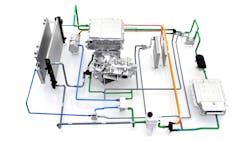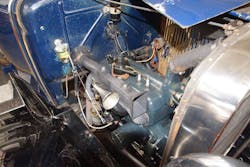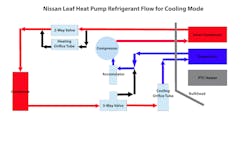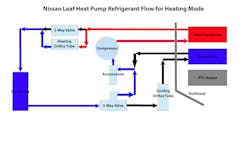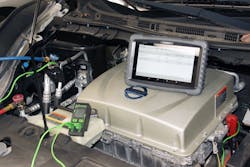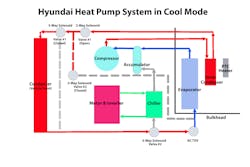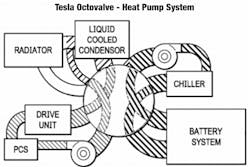Content brought to you by Motor Age. To subscribe, click here.
What You Will Learn:
• The principles of HVAC and refrigeration remain unchanged
• Heat pumps produce more energy than what is required to operate them
• Heat pumps work well with EVs because they place no significant load on the vehicle's HV battery.
The heat pump climate control system of an EV is a bit more intricate than that of a typical ICE vehicle, but the basic principles of refrigeration still apply.
With the auto industry’s rapid movement from internal combustion engines to electrified powertrains, the task of conditioning the vehicle’s interior is changing significantly. Auto manufacturers are quickly adapting heating, ventilation, and air conditioning (HVAC) equipment to fit electric vehicles’ (EV) needs. For technicians expected to repair EVs, the learning curve is steep. However, the situation for current technicians is no different from what previous generations of techs tackled as vehicle technology advanced.Hyundai and Kia’s system additionally uses waste heat, contributing to its efficiency increase. GIF from Hyundai Motor Group
The history of HVAC
Over 120 years ago, the automobile was in its infancy. As such, the vehicle occupant’s heating consisted of coats, blankets, winter caps, face coverage, gloves, and boots for the operator and riders (Figure 1). The occupants' comfort was a minor manufacturer’s concern during the open-cab, horseless carriage period. In addition to winter clothing, some owners installed brick boxes into their cars to provide a source of heat. In both cases, the occupant's heating relied upon a source other than the vehicle.
The methods of occupant heating changed as vehicles moved from the open carriage design to enclosed cabins in the early 1910s. First, the enclosed interior provided additional occupant protection from harsh weather and cold temperatures. Then, in the 1920s, closed-body vehicle production surpassed open-body models. At about the same time, the original equipment manufacturers (OEMs) developed exhaust heaters to provide vehicle interior heating. The exhaust heaters used engine exhaust to warm a radiator-like exchanger placed under the vehicle floor or at the feet of the riders.
By the late 1920s, the OEMs began casting (or fabricating) shielding around the exhaust manifold. Air was channeled, with the aid of the engine’s radiator fan, over the exhaust manifold, and the shielding directed the heated air to the vehicle’s interior (Figure 2). The engine proved to be an excellent source of heat, but the use of engine exhaust raised concerns about exhaust emissions entering the car. At the same time, some manufacturers developed gasoline heaters (with similar emissions concerns), which remained an option for specific vehicle models until the 1960s.
It wasn’t until 1930 that General Motors produced the modern industry standard heater core. Hot coolant from the engine was plumbed into a heater core (a small radiator) under the dash. A blower motor moved air across the heater core. The heat picked up by the passing air was distributed to various discharge nozzles at the dashboard. As years passed, a maze of ductwork feeding a series of discharge vents was placed at multiple interior locations.
As automotive technology advanced, repair technicians had to master new concepts, which included the evolution of coolant (from water to mixed blends), pressurized cooling systems, and air conditioning (A/C) operation. Although air conditioning was an option for some automakers starting in the 1930s, it was not until after WWII that manufacturers began standardizing the location of the significant components.
All domestic auto manufacturers had similar A/C systems, but when the Asian cars hit the US market, there were new systems to learn. As a result of the oil embargo in the 1970s, additional operating methods (such as cycling A/C systems) were introduced. The complexity grew with each technological advancement. And with the advent of computer controls, the system’s efficiency increased appreciably, but so did the intricacies of repairing the systems. Then, like today, those technicians had to constantly learn emerging technology and apply that newfound knowledge, whether they wanted to or not if they desired to stay in the automotive industry.
So, what is the latest heating and cooling technology that technicians in the EV era must learn? It is the heat pump. The heat pump system encompasses vehicle interior heating with the air conditioning system. The first mass-produced heat pump usage was established by Nissan, which installed a heat pump on the Leaf over a decade ago.
Before we get in-depth about heat pump systems, a few clarifications need to be mentioned. First, some texts suggest that the compressor’s scroll spins in its normal direction during A/C cooling and is rotated in the opposite direction for the heating mode. Thus far, this writer has yet to come across a heat pump system with a compressor that reverses.
Second, it is a gross understatement to say a vehicle’s heat pump has a solenoid-controlled reverser or slider valve (like a house HVAC design) to allow or redirect the refrigerant flow from the compressor. Yes, the refrigerant in an automotive heat pump system is permitted or blocked from flowing. However, there are multiple solenoids, restrictions, and condensers throughout the design, depending upon the application.
While the first heat pumps had an acceptable interior warming performance at temperatures slightly below 32 degrees F., with advancing heat harvesting techniques, heat pumps have developed into a more viable low-temperature choice for interior heating. Although another heat source may be developed in the future, because of the benefits of the heat pump systems, many, but not all, auto manufacturers are adopting them.
The two significant advantages of a heat pump are its ability to heat and cool the cabin air and provide more heat energy than is required to operate it. The heat delivered versus the input power is known as the coefficient of performance (COP).
A positive temperature coefficient (PTC) or resistive heater will have a COP of nearly one. Therefore, it cannot deliver more heat than the energy supplied. However, the heat pump systems can achieve a COP more substantial than one. For example, many manufacturers list a COP of 2.0 – 5.4, which means a heat output of double to over five times the input energy required to operate it.
The limiting factor of a heat pump is that the system is most efficient at a narrow temperature band near or just below 32 degrees F., but the efficiency drops as the temperature falls. Therefore, a heat pump cannot provide adequate interior heat and requires a backup heat source, a resistive or PTC heater. As previously discussed, the heater draws more battery energy to supplement the heat pump and maintain interior temperature.
Modern cars have never had significant insulation to maintain the interior temperature, thus exacerbating the heating problem. Additionally, each vehicle has a positive airflow ventilation system to provide constant fresh air into the interior to keep the occupants in a pleasant atmosphere with the windows shut. So, the HVAC system’s capacity must be several times larger than required based on air volume. The result is more energy consumed to maintain the interior temperature (in colder ambient temperatures), which shortens the distance the EV can travel because it depletes the HV battery.
Many manufacturers are utilizing efficient seat and steering wheel heaters to combat the loss of cabin heat. As with gasoline vehicles, the seat and steering wheel heater transfer warmth to the occupants via conduction. Heating the person rather than the air can reduce the heat pump or heater usage. However, minimizing cabin air heating can only be expected to work so well in frigid temperatures, and there will still be a loss of energy from the battery thermal management system.
Currently, BMW, Hyundai, Jaguar, Kia, Mini, Nissan, Polestar, Subaru, Tesla, Toyota, Volkswagen, and Volvo offer a heat pump as a standard or an optional component in at least one of their hybrid or electric vehicles. Chevrolet and Ford do not provide heat pumps for EVs. However, all the manufacturers listed have a standard or optional "cold weather" or "comfort" package that includes a combination of heated seats, steering wheel, windshield, mirrors, batteries, and PTC or resistive heaters.
Cooling mode of the Nissan Leaf
The Nissan Leaf is the least complex system on the list of vehicles. Therefore, we will begin with an examination of its heat pump system (Figure 3). When the cooling mode is selected, the scroll compressor pushes a gas refrigerant through the bulkhead and into the inner condenser housed in the HVAC box (Figure 4). Then the refrigerant flows through the inner condenser and back toward the motor bay. After passing through the bulkhead, the refrigerant flows to the two-way valve.
While still in cooling mode, the two-way valve bypasses the heating orifice tube and allows the refrigerant to move to the condenser at the front of the vehicle. After it passes through the front condenser, the refrigerant approaches a second valve, called a three-way valve. The valve is constructed to allow refrigerant to pass through the cooling orifice tube (restriction) and move back into the HVAC box as it enters the evaporator. Ultimately, the refrigerant goes from the evaporator to the accumulator and then back to the compressor.
The refrigerant exiting the compressor is a hot, high-pressure gas that passes through the inner condenser and the two-way valve to the front condenser. The refrigerant gives off latent heat at the front condenser and changes from a high-pressure gas to a high-pressure liquid. After the front condenser, the refrigerant goes through the three-way valve and onto the restriction. Across the restriction, the high-pressure liquid pressure becomes a cold, low-pressure liquid that passes through the evaporator. The refrigerant takes on heat and changes into a low-pressure gas. Finally, the gas flows from the evaporator to the accumulator and back to the compressor.
Except for the inner condenser and the two- and three-way valves, the HVAC cooling mode is very similar to the operation of a conventional vehicle’s HVAC refrigerant loop. The inner condenser takes the place of the traditional heater core. But in cooling mode, it does nothing except allow the refrigerant to pass through (Figure 5). In addition to the inner condenser, a positive temperature coefficient (PTC) heater is housed in the HVAC box. The two-way valve is in bypass mode, and the three-way valve permits the movement of refrigerant to the system’s restriction when in cooling mode.
Heating mode of the Nissan Leaf
Switching from cooling to heating mode requires the activation of the two-way valve to force refrigerant to flow through the heating orifice tube (Figure 6). At the same time, the three-way valve moves to bypass the restriction and evaporator routes the refrigerant directly to the accumulator.
When in heat mode, the hot, high-pressure gaseous refrigerant flows from the compressor to the inner condenser, where the refrigerant gives off heat and changes to a hot, high-pressure liquid. The pressure drops across the heating orifice tube, and a low-pressure liquid flows to the front condenser. The refrigerant absorbs heat from the ambient air at the front condenser, changing from a cold, low-pressure liquid to a cold, low-pressure gas. Lastly, the refrigerant moves through the three-way valve to the accumulator and returns to the compressor. In the heat mode, the evaporator is bypassed (Figure 7).
During de-ice mode, the heat pump prevents the icing of the front condenser during pre-conditioning battery charging. The three-way valve routes refrigerant across the cooling orifice tube and through the evaporator, while the two-way valve is opened and bypasses the heating orifice tube. The pressurized refrigerant flows through the system to warm the front condenser to warm it and melt the ice.
The Hyundai and Kia heat pump configuration is like the Nissan system. The similarities include a compressor, an inner condenser, an outer condenser (Hyundai/Kia term), an evaporator, an accumulator, and a PTC heater. However, the system has increased heat output and window defrosting. The system has two two-way solenoid valves, two three-way solenoid valves, a thermostatic expansion valve (TXV), and a liquid-to-liquid chiller.
Alternative designs
When in cooling mode, the compressor pumps the high-pressure gaseous refrigerant through the inner condenser, the two-way solenoid valve #1 (in its open position), and through the 3-way solenoid valve #1, routing the refrigerant through the outer condenser (Figure 8).
The outer condenser gives off heat, and the refrigerant changes from a hot, high-pressure gas to a hot, high-pressure liquid. Next, the refrigerant flows through three-way solenoid valve #2, across the TXV and through the evaporator. The TXV (variable restriction) drops the system pressure, and once in the evaporator, the cold, liquid refrigerant takes on heat and cools the air flowing over it. Ultimately, the low-pressure gas refrigerant flows through the accumulator and returns to the compressor.
In heating mode, the high-pressure gas refrigerant exits the compressor and enters the inner condenser housed in the HVAC box (Figure 9). The inner condenser gives off heat to the air passing over it, and the refrigerant changes from a hot, high-pressure gas to a hot, high-pressure liquid. After the refrigerant exits the inner condenser, it passes across the 2-way solenoid valve #1 that acts as a restriction, dropping the refrigerant pressure and temperature.
The low-pressure liquid moves through the three-way solenoid valve #1, which allows the refrigerant to flow through the outer condenser at the front of the vehicle (unless frost is detected on the condenser, then it will divert the refrigerant around the condenser). In either case, the refrigerant travels through the three-way solenoid valve #2. If the refrigerant moves through the outer condenser, it picks up the heat, and the refrigerant changes state to a gas. Conversely, if the refrigerant bypasses the outer condenser, it remains a low-pressure liquid.
In either case, the refrigerant is guided through the chiller, which picks up heat, and the remaining low-pressure liquid changes its state to a gas. The refrigerant enters the accumulator and subsequently moves back to the compressor.
If the defroster is desired, the two-way solenoid valve #2 (located between two-way solenoid valve #1 and three-way solenoid valve #1) permits low-pressure/low-temperature liquid refrigerant to flow through the evaporator. The air in the HVAC box is dehumidified before the inner condenser heats the air. The refrigerant from the evaporator returns to the accumulator and back to the compressor.
Tesla’s innovation
The Nissan, Hyundai, and Kia heat pump systems are similar in design, with the components located throughout the under-hood area and under the dash. However, the Tesla heat pump system is much more compact, allowing a better fit into tight spaces under the hood. To achieve compactness, Tesla developed the Super Manifold, a two-layer printed circuit board (PCB) assembly that houses the refrigeration system on one side, while the other side is plumbed for coolant.
To manage the heating and cooling loops of the Tesla heat pump system, Tesla devised a pair of four-way valves stacked on top of each other and attached them to a coaxial motor. The valve assembly is called the Octovalve (Figure 10). Its design allows refrigerant and coolant to flow through a series of channels to provide heating or cooling without mixing. With the Octovalve system, a ninth pipe configuration works as a bypass to the radiator circuit.
The refrigeration loop consists of a liquid-cooled condenser (LCC), a cabin condenser for the heating modes, a chiller, and a cabin evaporator for the cooling modes. There are five coolant loops in the system. In addition to coolant loops for the LCC and chiller, there are loops for the batteries, the Power Conversion System (PCS) and drive unit, and the radiator to provide proper cooling or heating. With the multiple orientations of the Octovalve, Tesla has developed a system with twelve heating and three cooling modes.
While it would be beneficial to investigate all the heat pump systems in greater depth, it is simply impossible to achieve in a few pages. With each passing year, system refinement will continue. Until a specific heat pump design becomes the standard, enjoy the “Wild West” and remember, just like the techs of years past, constantly updating training is necessary to repair the customer's vehicle correctly the first time.
About the Author
Christopher J. Holley
Contributing Editor
Christopher J. Holley is a professor of automotive technology in the School of Engineering Technology at Pennsylvania College of Technology (Williamsport, Pa.). Since 2003, Holley has primarily instructed electrical/electronics, heating, ventilation, and cooling (HVAC), and vehicle performance classes. In 2011, he earned the Excellence in Teaching Award.
From 1998-2003, Holley was a professor at North Metro Technical College (Acworth, Ga,), teaching all facets of the automobile. He received the Teacher of the Year award in 2003. Before his employment as a professor, he worked as an automotive technician for Lexus. He also was employed at Sears during his early years of college.
Holley earned a master’s degree in management information systems from Southern Polytechnic State University, a bachelor’s degree in information systems from Kennesaw State University, and an associate degree in automotive technology from Floyd College/North Metro Technical Institute.
He is an ASE Certified Master Automotive Technician with several advanced ASE certifications and has authored over 300 published magazine contributions.
